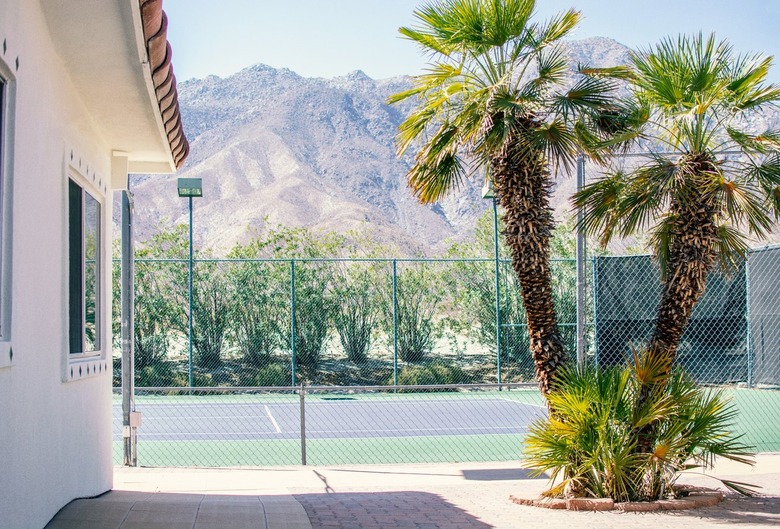The Life Cycle Of A Palm Tree
We may receive a commission on purchases made from links.
Whether you're trying to propagate a smaller palm plant like an areca palm (Dypsis lutescens, USDA zones 10-11) indoors or cultivate a larger tree, such as a coconut palm (Cocos nucifera, zones 10-12), understanding their growth stages can be a huge help. The life cycle of a palm tree is similar to that of most flowering plants (though the initial vegetative stage may be longer than average), and tailoring your care to different growth stages can help ensure a healthy plant.
Germination From Seed
Germination From Seed
All varieties of palms are monocots, meaning each seed contains only a single embryonic leaf. In nature, the seeds fall to the ground and germinate there, either remotely (with the root emerging from the stem with the first leaf still inside the seed) or adjacently (where the first leaf slightly emerges from the seed and the stem and root grow from there).
If you're trying to germinate your seeds at home, it can be a process of several weeks or more, depending on the type of palm. When purchasing palm seeds, greener ones are less mature and will take longer, while seeds that are more orange in color are older and will germinate more quickly. However, very old seeds may also struggle to germinate.
To begin the germination process, sow your seeds in a seed-starting mix. Keep your palm seeds in small individual pots with adequate drainage. Seeds need moisture to germinate, so water them regularly. Bright, indirect sunlight and a temperature between 70 and 85 degrees Fahrenheit will provide the ideal conditions for germination. After around two months, most species of palm seeds should have sprouted, although certain seeds can take years.
Growth of a Palm
Growth of a Palm
Once your palm seed has germinated and sprouted (usually at around six months), it can be gently moved to a larger pot. Growing your palm from a tiny seedling into a large plant is a long process, so patience is key here. It will take a couple of months for you to see inches of growth and several years before your plant resembles a true palm. As a palm grows vertically, it will shed its old, dead leaves. This is what gives the palm plant its distinctive scar markings on its stem or trunk.
To help give your new palm plant the best chance at growth, the proper care is required. A bright, warm area with high humidity is ideal. Water your plant whenever the top 2 inches of its potting mix begin to feel dry. If you live in a warm climate, your palm can benefit greatly from spending the summer outdoors.
Palm Plant Flowering
Palm Plant Flowering
In spite of their name, palms are not true trees. They don't have wooden trunks, and their stems increase by caliper growth. This means they widen their trunks by expanding the tissues already present there.
Palm flowers grow in large clusters called inflorescences but are relatively small alone. These flowers will usually begin to show at the beginning of the warmer growing season. In tropical climates, these flowers can bloom on and off throughout the year. Some palms flower only once in their lifetime, after which new stem growth will start from the plant's base.
Palm Fruit Set
Palm Fruit Set
Palms are not self-pollinating, requiring wind, insects or animals to pollinate their flowers. After pollination, their flowers will turn into clusters of fruits. Palm plant fruits typically contain one seed, though there are exceptions. In the wild, fruits drop from the tree and are eaten by animals. The droppings of these animals spread the seeds, which begins the process of germination and growth once more.
Life Span of a Palm
Life Span of a Palm
In addition to the influence of environmental factors on a palm's life span, such as climate, soil and nighttime temperatures, a palm's development also varies according to species. For example, according to an article by David Byres, a biology professor at Florida State College at Jacksonville, the pindo palm (Butia odorata, zones 8-11) has a life span of about 80 years. The life span of the betel nut palm (Areca cathecu, zones 11-12), on the other hand, may vary between 60 and 100 years, notes the University of Guam Cooperative Extension & Outreach.
References
- University of Florida IFAS Extension: The Coconut Palm in Florida
- PennState Extension: Plant Life Cycles
- Missouri Botanical Garden: Cocos nucifera
- Clemson Cooperative Extension: Indoor Palms
- Royal Horticultural Society: Palms (Hardy)
- Missouri Botanical Garden: Dypsis lutescens
- Florida State College at Jacksonville: Pindo Palm : Butia capitata
- University of Guam Cooperative Extension & Outreach: Betel Nut: Areca cathecu
- Midland Reporter-Telegram: Various Factors Determine Life Span of Tree
